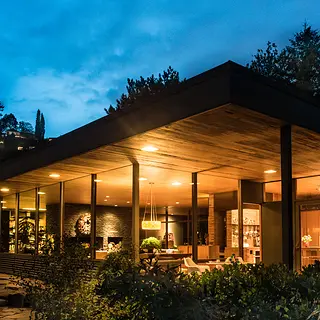
Photo Tour: The Burkes-Belluschi House in Portland, Oregon
It’s somewhat unusual for an architect to purchase a house he or she originally designed for a client. But Pietro Belluschi, a pioneering Pacific Northwest Modernist, was not a typical architect.
The subject of a feature story in the Spring 2016 issue of Preservation magazine, Pietro designed a wood, glass, and stone residence for Clint and Genevieve Burkes in the late 1940s. He bought the Portland, Oregon, house about 25 years later, and his architect son Tony and daughter-in-law Marti now live there. They’ve lovingly restored and renovated it, often opening it up to the local community.

photo by: Dina Avila
Tony Belluschi and a team of craftsmen restored the cedar walls in the Burkes-Belluschi house's library. After adding more shelving, Tony combined his collection of architecture books with his father's.

The house's low-key front entry is sheltered by a trellis of gray-painted cedar. Tony Belluschi added a garage door to the former carport.

Giant fireplaces are a signature Pietro Belluschi touch. The one that anchors this house is made of local Mt. Adams stone.

The original rotisserie oven and extra-long bricks in the kitchen have been carefully cleaned. New cabinetry, appliances, and an expanded footprint improved the room's functionality.

Tony replaced the original cork floor and restored the noble fir ceilings in the main living space.

The addition on the south end of the house, designed by Tony Belluschi, provides extra storage and sleeping space. It's connected to the main house by a glass-ended gallery.

Left: The master bedroom's restored, woven-wood ceiling is a mix of different wood types, and the new outbuilding is visible across the courtyard. Right: the ladder to a loft space in the house's addition.

Pietro Belluschi designed the house to be equally enjoyable on a sunny or overcast day. Its human-scaled outdoor spaces and glass walls provide constant opportunities to take in sweeping views of Portland.
“In Portland there is some appreciation for Midcentury Modernism, and it’s growing, but it could be bigger,” says Judith Sheine, professor and department head at the University of Oregon’s architecture school. “It’s great that Tony wants to use his background, experience, and family heritage to promote not only his father’s legacy but modern architecture in general.”
Tony Belluschi has spent most of his career designing large mixed-use and retail buildings, and he reveled in working on the 2,500-square foot house, to which he added a 750-square-foot guest suite and a separate 235-square-foot outbuilding.
“I learned about color, scale, proportion, and materials from my dad,” he says. “All these things are basic tenets of good design that speak to every project. They’re just as important in small buildings as big buildings; every square inch counts.”



